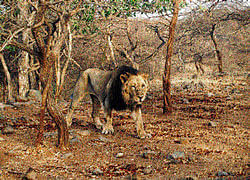
Gandhi and the Asiatic Lion — these were the two things that always attracted us to Gujarat the most. Gandhi’s philosophy and lions have become rare today, almost on the verge of extinction. Hopefully, at least the lion will be saved.
Asiatic lion that found a place in mythology, historical emblems and tales from the Iranian to the Indian civilisations, and whose territory spread from Central Asia to the Indian subcontinent, has nearly been wiped away from its entire range, except the Junagarh forests of Gujarat. The last lion reported from Iran was in 1930, and by the start of the 20th century, the lion from India had vanished from most of its habitat. The far-sightedness of Junagarh Nawab saved lions from extinction in India. Although inaccurate accounts try to discredit the Nawab’s efforts, the historical references say otherwise.
The Gir National Park and Wildlife Sanctuary, the last remaining home of the Asiatic lion, is spread across an area of 1,412 sq km in Sasan Gir near Junagarh. The best time to visit Gir is during the peak summer months of April and May, when the water is confined to a few waterholes in the forest. Moreover, the dry deciduous forest is more open at this time, than after the lush vegetation growth post-monsoon. This increases the visibility and spotting of animals.
Safari schedule
If the sole objective is not to see a lion, one can enjoy the forest and its rich flora and fauna. While sloth bears, panthers, reptiles and jungle cats are difficult to come across, animals like mongoose, chital, blue bulls, sambars, four-horned antelopes, chinkara and wild boars are easier to spot. A tawny eagle perched high on a branch, a collared owl camouflaged inside a tree-trunk hole, a stone plover sitting still on the ground, or nightjars peacefully sleeping on low branches are the little delights of a Gir safari.
There are two safari timings every day, and limited permits are given for eight clearly demarcated routes inside the sanctuary. Guides and tourists line up every morning in the forest guesthouse from where the permits are issued. You can either take your own car, if it meets the pollution norms, or hire a jeep, but a guide is mandatory. Trackers, who are well-versed with the forest, start before the tourists, to locate the movement of lions.
They in turn inform the guides and drivers about lions on various routes. Later in the day, one may just see the lions lazing around. Early morning hours are the best to catch a retreating lion on prowl. Mist floats in the early morning hours inside the forest, even in the summers, and you feel transported to a different world. The most delightful moment can be if a lion emerges from the mist, walking along the path just an arm’s length away from you.
Tribal trivia
There are tribal villages inside the forest, which seem to be frozen in time. One of the villages is of Africans, brought here by the erstwhile Nawab. Do not be surprised to find an African tracker speaking in Gujarati, and walking behind a lion named Maulana. The sanctuary management, especially the involvement of tribals living inside the forest, is commendable. The lions have become acclimatised to human presence and don’t mind the trackers walking behind them, a baton in hand. But there have been rare instances of lions and panthers attacking the trackers.
A trip to the Gir Interpretation Zone at Devalia may be good for an evening without any engagements. You can take a bus safari inside the fenced zone, which houses a few lions and other wildlife.
We were lucky to spot no less than 30 lions of the 411 living in Gir. For an almost equal number of panthers found in that forest, we were able to see only one — the most majestic one that we’ve ever laid our eyes on! The lion is the regal king, but the splendour, cunning and agility of the Indian Prince remains unmatched.
There are many places to stay in Sasan Gir, including Club Mahindra Safari Resort, Taj Gir Lodge and the 100-year-old Sinh Sadan forest guesthouse. The service is tardy and food average at Sinh Sadan, but with its large cottages, gardens, information centre and the safari permit office located right inside, it is a good place to stay. There are new rooms with modern amenities available for the same price, but the bureaucratic staff generally prefer to keep it for visiting or holidaying government employees.
Rocky road
If you’re driving down from some other state, it is better to be specific and look for Sasan Gir, not Gir Wildlife Sanctuary or national park while searching the road maps on Google. The large periphery of the park can be misleading, as the entrance and hotels are located at Sasan Gir. We had to drive an additional 100 km because of the faulty road map.
Gir is protected because of the efforts of the forest department, wildlife activists and organisations. The homogenous gene pool, increasing number of lions exceeding the carrying capacity of the park, and the fear of a natural disaster or disease, looms over the fate of the Asiatic lions confined to only one place. We left Gir with the hope that the Asiatic lion will once again have greater grounds to tread and bigger territories to rule. Until then, to answer the call of the Asiatic lion, one has to go to Gir — its last standing bastion.